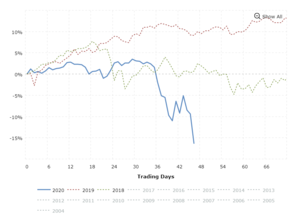

In this case the estimate gives the exact answer of zero for the CAGR: In the example at the top of the page, the simple average is 25% and the standard deviation is 75% (since the data points of +100 and -50 lie at a distance of 75 away from the simple average) There is a formula that lets you estimate the CAGR if you already know the simple average and the standard deviation:
#S&P 500 PERCENT GAIN 2017 SERIES#
Try the inflation-adjusted returns for 1916-1918, 1946-1947, and 1973-1981. The chart below is a continuation from our 2014 series and tracks the 10-year rolling annualized returns of the Standard & Poors (S&P) 500 Index. Over the very long run, the stock market has had an inflation-adjusted annualized return rate of between six and seven percent.Īnother pattern: while stocks have certainly beaten inflation over the long run, they've done poorly within the high-inflation periods themselves: You'll find that the CAGR is usually about a percent or two less than the simple average. They are up nearly 36 percent for the year, double the S&P 500s gain. This calculator lets you find the annualized growth rate of the S&P 500 over the date range you specify Tech stocks in the S&P 500 rose 0.6 percent, and they trimmed their loss for the week to 0.3 percent. Volatile investments are frequently stated in terms of the simple average, rather than the CAGR that you actually get. The zero percent that you really got is the "geometric mean", also called the "annualized return", or the CAGR for Compound Annual Growth Rate. In this example, the 25% is the simple average, or "arithmetic mean". You certainly wouldn't say that you had an average return of 25% = (100% - 50%)/2, because your principal is back where it started: your real annualized gain is zero. CAGR of the Stock Market: Annualized Returns of the S&P 500Ĭompound Annual Growth Rate (Annualized Return)Ī problem with talking about average investment returns is that there is real ambiguity about what people mean by "average".įor example, if you had an investment that went up 100% one year and then came down 50% the next,


 0 kommentar(er)
0 kommentar(er)
